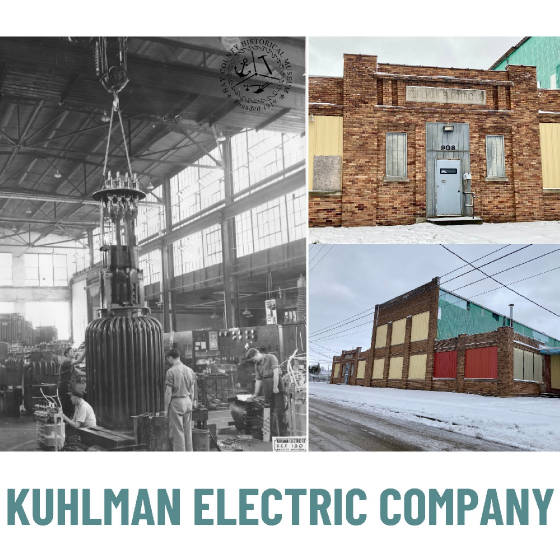
by Sam Fitzpatrick
(Black & white photo: Four men working on or around large transformer hung from overhead crane with
other machines and factory windows behind them.)
Located in Bay City’s South
End, on 26th Street between Garfield and Jefferson, is the former Kuhlman Electric Company building. The company was founded
in 1894 by Etna Kulman in Elkhart, Indiana. As the company grew and prospered, it made several moves to accommodate its expanding
needs. By 1915, it found a home in Bay City and situated inside a 15,000-square-foot one-story building. The company manufactured
electrical transformers primarily used by power distribution companies for power, welding, street lighting, furnace work,
etc. The plant held its formal opening on October 28, 1916. Tours were provided for the Board of Commerce, who helped relocate
the company to Bay City.
The company was busy from the get-go. In 1916, Kuhlman
Electric received an order from the City of Milwaukee for 3,404 electric transformers for its new streetlight plan. This was
one of the largest orders ever for a transformer manufacturer. In addition, the City of Chicago submitted an order for 100
transformers for the Lincoln Park neighborhood. By 1929, it was still the only company in Michigan making electrical transformers.
Their presence grew nationally, with orders filled for clients as far away as the Pearl Harbor Navy Yard.
The plant was noted in The Bay City Times as
being a “daylight” plant. It was built at the convenience of the employees with large glass panes for increased
visibility while working. In 1926, the plant grew in size to 35,000 square feet. By the 1930s, the company had grown to 300 employees. In 1936, the company acquired two conjoined buildings,
which doubled its size to 87,000 square feet.
Advertisement source: Polk City Directory, 1944: 32.

During the 1930s, a large portion of Kuhlman’s
market was the result of the electrification of rural United States. In 1936, the Rural Electrification Act (a part of President
Roosevelt’s New Deal) was signed, which provided rural America with access to electricity. At this point, nearly 90%
of America’s farms did not have electric power as it was cost-prohibitive. Through this Act, companies like Kuhlman
Electric were able to produce parts to make this possible. By 1950, nearly 80% of American farms had electric power.
Before World War II, the plant had grown to 450 employees. During the war, the Army
awarded Kuhlman contracts reaching in the $1 million range, which resulted in the need for an additional 40-50 employees.
Throughout the war, Kuhlman Electric produced transformers and Detroit Electric Furnaces.
On March 3-7, 1944, a "War Exhibit" was showcased at the Bay City Armory. It exhibited items produced by
Kuhlman Electric, Bay City Chevrolet, Defoe Shipbuilding, and other industries. Kuhlman displayed a huge rocking electric
furnace weighing 350-500 pounds.
Kuhlman was comparable to Industrial Brownhoist and Defoe Shipbuilding in terms of industrial might.
It was one of Bay City’s largest employers until falling on hard times during the early 1970s. Changes in the market
saw a decrease in orders. As a result, the headquarters in Birmingham, Michigan, decided to suspend operations for the first
quarter of 1971. In 1973, Kuhlman Electric signed a new three-year contract with Local 778, United Auto Workers (UAW). At
the end of the contract in 1976, the building was closed. Ownership transferred to the City of Bay City, which leased the
building to the National Insulation Company of Cheboygan, Michigan. In March of 1977, the remaining production equipment was
auctioned off. Some areas of the building still had pieces of electrical components made during World War II. In late 1979,
the pension program set up in 1958 for Kuhlman retirees went broke while being managed by a Detroit firm. After a court case,
payments resumed to pensioners in February of 1981.
Since Kuhlman's closed,
the site has seen businesses come and go. Currently, the site is vacant.
Sources:
“Kuhlman Electric Had Steady Growth”. The Bay City Times. February
28, 1937.
“Checks finally arriving
for Kuhlman retirees”. The Bay City Times. February 22, 1981.
“End of Kuhlman eyesore may be in sight for city”.
The Bay City Times. September 7, 1980.
“Kuhlman Electric Co., The Men Behind it and What it Produces”. The Bay City Daily Times. October
27, 1915.
“Formal Opening of
Kuhlman Plant”. The Bay City Daily Times. October 13, 1915.
“Will Supply Its Transformers to Milwaukee”. The Bay City Times Tribune.
September 23, 1916.
“Kuhlman
Planning Further Expansion”. The Bay City Daily Times. November 17, 1929.
“Firm Plans Program of Expansion”. The Bay City Times Tribune. April
20, 1936.
“Kuhlman Given New
Army Job”. The Bay City Times Extra. September 16, 1943.
“Kuhlman to Suspect Bay Plant Operation”. The Bay City Times. November 23,
1970.
“Kuhlman Pact Sees New
Jobs”. The Bay City Times. January 9, 1973.
Honsowetz, Duane. “City Oks Leasing Kuhlman Property”. The Bay City Times. July 26, 1977.
“Kuhlman Equipment Auctions”. The Bay
City Times. March 14, 1977.
“Tear
Down Kuhlman Plant, Planners Say”. The Bay City Times. December 17, 1976.
“Recycling Business is succeeding here in once-abandoned Kuhlman facilities”.
The Bay City Times. November 9, 1981.
“War Show”. The Bay City Times. May 4, 1944.
Kuhlman Electric, ”The Men and Women of Kuhlman Electric Cordially Invite You To Visit Their
Booth at the Bay City Industrial War Exhibit”. Advertisement. The Bay City Times, April 30, 1944, page 14.
McBride, Brandon. “Celebrating
the 80th Anniversary of the Rural Electrification Administration.” USDA, May 20, 2016. https://www.usda.gov/media/blog/2016/05/20/celebrating-80th-anniversary-rural-electrification-administration.

by Claire Clark
Planning is currently underway
for our next exhibit which will feature amusements and carnivals at Wenona Beach, Tony’s, Deer Acres, and the amusement
park that never was, Little Michigan.
John Rabior was credited as being the
original architect of the Wenona Beach amusement park. He was born in Canada and moved to the United States as a seven-year-old
boy. He later married and went on to have four children, John Jr., Frank, Rose and Marie (Mary). He owned the Bay City Saginaw
Gun and Fishing Club and operated the Bay Shore Hotel, which was across the street. The Hotel was attached to his large home
and hosted many of the beach performers such as the Marx Brothers and W.C. Fields. The hotel burned down in 1916, but his
attached house remained unharmed. The Cavanaugh Fish Company had a lease on the land and planned to reclaim the property.
To avoid losing his home, Rabior planned a covert operation. Late at night on a Sunday in 1916, Rabior used logs and oxen
to move his large home across Patterson Avenue. His seven-year-old granddaughter, Peg Campbell, was asleep inside the home
as it moved to its new location. Rabior fenced in his new property to create a pond and raised ducks and chickens which he
in turn sold to area restaurants.
John Rabior was also the owner of the soft
drink saloon at the entrance of Wenona Beach. In April 1924, he was arrested for violating prohibition laws. A raid led by
State Police Sergeant Joseph Kearney, yielded enough evidence to arrest Rabior and lock him up in the county jail.
Found were two gallons of alcohol and 104 bottles of beer. He was charged with possession of liquor
and another charge of keeping a place where liquors are stored. Arraigned by Justice of the Peace Robert L. King, Rabior pleaded
not guilty and posted a $1000 bond. He was scheduled to appear in court on April 8, 1924, but no more information could be
found on the conclusion of the trial. After prohibition ended, Rabior’s Inn legally sold alcohol to Wenona Beach visitors.
John Rabior died on March 13, 1934, at the age of 71. He is buried in St. Patrick’s
cemetery in Hampton Township.
The Bay County Historical Museum’s
exhibit on the amusements of Bay County will debut on April 15, 2024. Please contact the museum at 989-893-5733 if
you have any memorabilia or relevant items from the four Bay County amusement parks.
Sources:
Watson, James R., Wenona Beach, Bay City, Michigan: J.R. Watson, 1988.
The Bay City Times Tribune, April 2, 1924, 215 edition
The Bay City Times Tribune, April 4, 1924, 217 edition
The Bay City Times Tribune, March 15, 1934, 74 edition
Bay County Historical Society Archive







